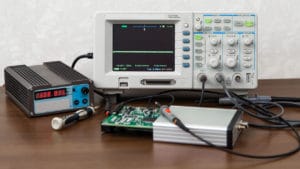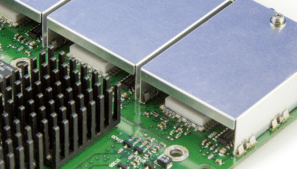SPEAG and Rohde & Schwarz expand their long-term collaboration with the combination of the CMX500 wideband radio communication tester with the DASY83D utilising the enhanced DASY8 Application Programming Interface. This combination allows manufacturers of wireless devices to perform Specific Absorption Rate tests of 5G FR1 devices using the future-proof CMX500 … [Read more...]
EMV 2025: Rohde & Schwarz Presents New Antenna for EMI Measurements in Frequency Range from 14.9 GHz to 44 GHz
At the EMV 2025 tradeshow in Stuttgart, Rohde & Schwarz displays for the first time its R&S HF1444G14 High-gain EMI microwave antenna with outstanding performance. The antenna covers a frequency range from 14.9 GHz to 44 GHz. It meets the requirements of the standards CISPR 16-1-4 and CISPR 16-2-3. Precise mechanical construction and optionally … [Read more...]
An Easy Way to Calculate a Microwave Wavelength in Inches
A colleague, Mike Stasiowski, and I came up with this quick GHz wavelength formula while designing quad ridge circular polarized jamming antennas for the military when working at Nurad. The textbook formula (wavelength = c/f) where: c = the speed of light 3.00×108 m/s, and f = frequency in Hz, was cumbersome at times to calculate, then convert, to inches for practical … [Read more...]
Shielding Design Flow Chart
The flow chart in Table 1 will assist the designer in selecting the appropriate shielding options necessary to meet their shielding and environmental requirements. The shielding requirement flow chart begins by identifying the type of NEMA or IP enclosure based on the intended environment (indoor/outdoor, military/commercial, marine or land/desert). Then, using the resulting … [Read more...]
EMI Basics and Board Level Shielding Design
Introduction In today’s world full of digital electronic devices, electromagnetic interference (EMI) is a major concern in both military and commercial marketplaces. Electrical equipment can become susceptible to these undesirable emissions and malfunction due to their presence. The simplest and most cost-effective method for reducing EMI is to first attack it at the board … [Read more...]
Drag Races, a Cashless Society, and the Threat of EMP
About a month ago, my 12-year-old son and I made his first-ever trip to the NHRA Drag Races near our home. It’s something that I always did with my dad, and I have looked forward to taking him ever since he was born. It’s a typical father-and-son day, wrought with loud, fast cars, terrible food, and the occasional waft of nitromethane fuel in the air. The drive is about … [Read more...]
Advantages of Using a Pre-Certified Radio Frequency Module in an IoT Application
Learn the benefits of using a pre-certified radio frequency (RF) module in the design phase when building a new IoT application, and learn the implications in EMC and Radio certifications. The Internet of Things (IoT) is revolutionizing the quantity and manner in which we exchange and store information. Historically, people exchanged information through reading and … [Read more...]
Design for Compliance Essentials
INTRODUCTION While unrealistic to discuss all aspects of product design in a single article, I’ll try to describe the most common design issues I find in the hundreds of client products I’ve had a chance to work on. These issues generally include PC board design, cables, shielding, and filtering. More detailed information may be found in the Reference section below. As … [Read more...]
How to Specify Board-Level Shielding
The Purpose of Board Level Shields Board level shields (BLS) are generally small metallic shielded boxes mounted directly to PC board ground return layers. There are three primary purposes of board level shields: Isolation of sensitive circuitry from other noisy circuits on the board Trapping the emissions from noisy circuits on a board from propagating to the outside … [Read more...]
Use of Ferrite-Loaded Absorber to Reduce Wireless Self-Interference
Self-generated EMI from DC-DC converters, as well as digital and video processing, has long plagued designers of wireless and IoT devices, especially since physical sizes have trended smaller. The broadband harmonic content often extends up through 1.5 GHz, which includes most wireless protocols, cellular LTE and GPS/GNSS bands. One new mitigation technique I’ve been trying … [Read more...]
- 1
- 2
- 3
- …
- 69
- Next Page »














